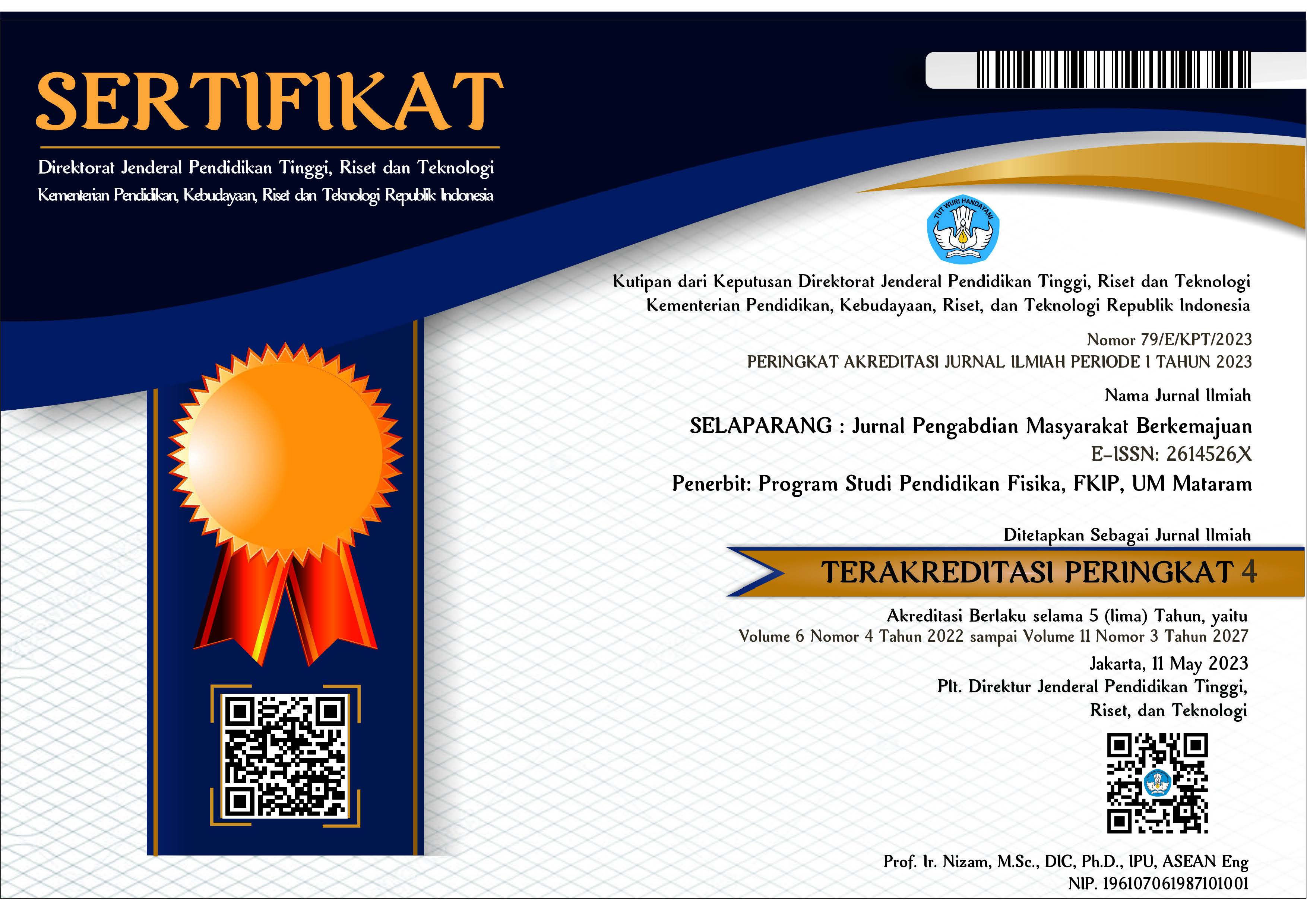EDUKASI SISTEM REPRODUKSI SEBAGAI UPAYA PENCEGAHAN PENYAKIT INFEKSI MENULAR SEKSUAL PADA REMAJA
Abstract
ABSTRAK
Menurut Centers for Disease Control (CDC) tahun 2021 penyakit menular seksual yang paling banyak dilaporkan dari berbagai negara adalah sifilis, gonore, klamidia, chancroid, dan HIV. Berdasarkan data pemerintahan Provinsi Kalimantan Selatan pada tahun 2017 menunjukkan bahwa terdapat 3 Kota/Kabupaten yang memiliki kasus infeksi menular seksual tertinggi di Kalimantan Selatan yaitu Kota Banjarmasin (3.507 kasus), Kabupaten Hulu Sungai Utara (3.134 kasus), Kabupaten Banjar (1.715 kasus) dan data dari kemenkes RI menunjukkan persentase tertinggi terdapat pada kelompok usia 25-49 tahun (71,3%), usia 20-24 tahun (16,3%). Tujuan pengabdian ini adalah meningkatkan pemahaman terhadap sistem reproduksi sebagai upaya pencegahan penyakit infeksi menular pada remaja dan membantu program pemerintah mencapai eliminasi HIV-AIDS dan penyakit infeksi menular seksual (PIMS) pada tahun 2030. Metode pengabdian adalah sosialisasi sistem reproduksi dan PIMS serta dialog interaktif/tanya jawab. Evaluasi dilakukan dengan diskusi tanya jawab, pretest dan posttest dengan peserta. Hasil kegiatan ini menunjukkan bahwa terdapat peningkatan pengetahuan mahasiswa/i dengan hasil rata-rata pretest (38,5) dan posttest (85,7). Kesimpulan kegiatan ini adalah terjadi peningkatan pengetahuan rata-rata sebesar 47,2.
Kata kunci: edukasi; sistem reproduksi; PIMS.
ABSTRACT
According to Centers for Disease Control (CDC) in 2021, the most reported sexually transmitted diseases from various countries are syphilis, gonorrhea, chlamydia, chancroid, and HIV. Based on data from South Kalimantan Provincial government in 2017 shows that there are 3 cities/districts that have the highest cases of sexually transmitted infections (STIs) in South Kalimantan, namely the city of Banjarmasin (3,507 cases), Kab. Hulu Sungai Utara (3,134 cases), Banjar Regency (1,715 cases) and data from kemenkes RI show that the highest percentage is in 25-49 year age group (71.3%), 20-24 years old (16.3%). This activity aimed to determine to increase understanding of reproductive system as an effort to prevent infectious diseases in adolescents and help government programs achieve elimination of HIV-AIDS and STIs by 2030. The program was carried out by following methods: the dissemination of reproductive system and STIs and interactive dialogue/ question and answer. Evaluation is done through question and answers discussion, pretest and posttest with participants. The results of this activity indicate that there is an increase in students knowledge with average results of pretest (38,5) and posttest (85,7). The conclusion is an increase in students knowledge with average increase 47.2.
Keywords: education; reproduction system; STIs.
Keywords
Full Text:
PDFReferences
Center For Control Diseases. (2021). Sexually transmitted diseases treatment guidelines 2021. Centers for Disease Control and Prevention., 70(4), 1–78.
Direktur Jenderal P2P. (2021). Laporan Perkembangan HIV AIDS & Penyakit lnfeksi Menular Seksual (PIMS) Triwulan I Tahun 2021. Kementerian Kesehatan RI, 4247608(021), 613–614. https://siha.kemkes.go.id/portal/perkembangan-kasus-hiv-aids_pims#
Ekawati, R. (2019). Pengantar kesehatan reproduksi. Wineka Media.
Hasheem, A., Ibrahim, R., Mukhtar, S., & Faris, M. (2021). Anatomy & Physiology of the Reproductive System. Research Gate, October, 1–59. https://doi.org/10.2174/9789815051667122050003
James, C., Harfouche, M., Welton, N. J., Turner, M. E., & Abu-raddad, L. J. (2020). WHO-bulletin HSV-2 2016.pdf. Bull World Health Organ, May 2019, 315–329.
Kemenkes RI. (2020). Rencana aksi kegiatan pencegahan dan pengendalian penyakit menular langsung tahun 2020-2024. In Direktorat Jenderal Pencegahan dan pengendalian penyakit.
Kusmiyati, Khairuddin, Sedijani, P., & Merta, I. W. (2020). Pengenalan Struktur Fungsi Organ Reproduksi Sebagai Upaya Pencegahan Kekerasan Seksual Pada Anak. Jurnal Pendidikan Dan Pengabdian Masyarakat, 3(3), 182–188. https://jurnalfkip.unram.ac.id/index.php/JPPM/article/view/2049
Kusumawati, W., Wahyuni, A., Cahyani, F. E., & Amalya, S. N. (2022). Upaya peningkatan kesehatan reproduksi melalui deteksi dini dan pencegahan gangguan haid serta menopause. SELAPARANG. Jurnal Pengabdian Masyarakat Berkemajuan, 6(September), 1164–1169.
Manik, P. (2022). Female Reproductive System. K G’s Medical University U P.
Martinez-Salazar, E. L., Tran, J., Patiño, A., Sureshkumar, A., & Catanzano, T. (2020). Infections of the Male and Female Reproductive System: Spectrum of Imaging Findings. Seminars in Ultrasound, CT and MRI, 41(1), 2–9. https://doi.org/10.1053/j.sult.2019.10.007
Mega Obukohwo, O., Eze Kingsley, N., Arientare Rume, R., & Victor, E. (2022). The Concept of Male Reproductive Anatomy. Male Reproductive Anatomy. https://doi.org/10.5772/intechopen.99742
Niforatos, J. D., & Rothman, R. E. (2022). Sexually Transmitted Infections Treatment Guidelines, 2021. Annals of Emergency Medicine, 80(1), 68–70. https://doi.org/10.1016/j.annemergmed.2022.05.017
Pemprov Kalsel. (2017). Jumlah Kasus Infeksi Menular Seksual (IMS).
Unemo, M., Lahra, M. M., Escher, M., Eremin, S., Cole, M. J., Galarza, P., Ndowa, F., Martin, I., Dillon, J. A. R., Galas, M., Ramon-Pardo, P., Weinstock, H., & Wi, T. (2021). WHO global antimicrobial resistance surveillance for Neisseria gonorrhoeae 2017–18: a retrospective observational study. The Lancet Microbe, 2(11), e627–e636. https://doi.org/10.1016/S2666-5247(21)00171-3
WHO. (2022). Sexually transmitted infections (STIs). In WHO Coronavirus (COVID-19) Dashboard | WHO Coronavirus (COVID-19) Dashboard With Vaccination Data. WHO. https://www.who.int/news-room/fact-sheets/detail/sexually-transmitted-infections-(stis)
DOI: https://doi.org/10.31764/jpmb.v6i4.11435
Refbacks
- There are currently no refbacks.

This work is licensed under a Creative Commons Attribution-ShareAlike 4.0 International License.
______________________________________________________
Jurnal Selaparang
p-ISSN 2614-5251 || e-ISSN 2614-526X
EDITORIAL OFFICE:



















